Lesson 2: Designing the User Interface in VB2022
Learn how to customize forms, set properties at design-time and runtime, and create professional VB applications
Key Takeaway
Designing an effective User Interface (UI) is the crucial first step in Visual Basic 2022 development. This lesson teaches you how to customize forms and controls to create professional, user-friendly applications.
Welcome to Lesson 2 of our Visual Basic 2022 Tutorial! In this lesson, you'll learn how to design the user interface for your applications. We'll cover everything from planning your UI to customizing forms at design-time and runtime.
2.1 Introduction to UI Design
Before creating your Visual Basic 2022 projects, it's essential to conceptualize your application. Whether it's a desktop game, multimedia app, financial tool, or database management system, having a clear vision is crucial.
1 Plan Your Application
Start with a paper sketch to visualize your design before using the VB2022 IDE. Spending 15 minutes sketching your UI can save hours of redesign later.
2 Design in VB2022 IDE
Customize the default form by modifying properties during design-time. Add controls from the toolbox and define their properties.

Understanding the Properties Window
The Properties window is your central hub for customizing form appearance. It contains:
Object List
Drop-down list to select different controls on your form
Properties List
Comprehensive list of properties for the selected object
Description Pane
Detailed explanation of each property's purpose
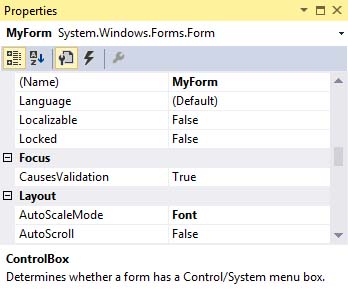
2.2 Customizing the Default Form
Let's configure these essential properties for Form1:
| Property | Value | Description |
|---|---|---|
| Name | MyForm | Identifier for the form in code |
| Text | My First VB2022 Program | Title bar text |
| BackColor | LavenderBlush | Background color |
| ForeColor | Crimson | Text color |
| MaximizeBox | False | Disables maximize button |
| Font | Arial, 9.75pt | Default font for controls |
You can select colors from three tabs in the color picker:
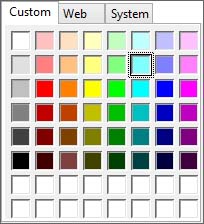
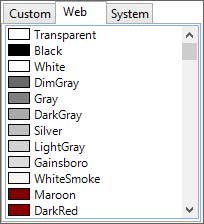
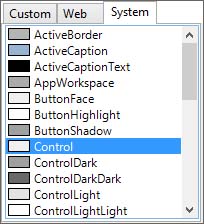

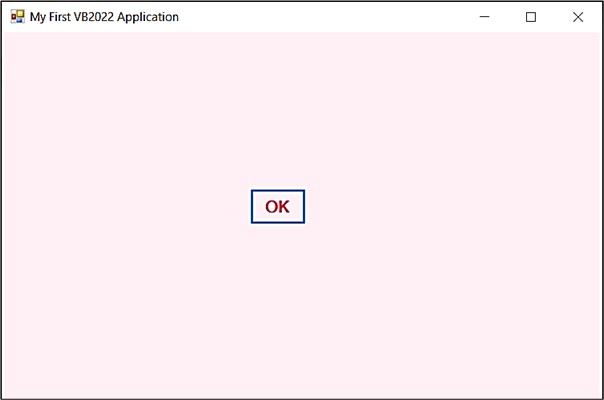
2.3 Changing Form Properties at Runtime
You can dynamically modify form properties during program execution using code. The default form is represented by the Me keyword:
' Change form properties at runtime Me.BackColor = Color.Cyan
Example 2.1: Setting Form Properties in Code
Public Class Form1 Private Sub Form1_Load(sender As Object, e As EventArgs) Handles MyBase.Load Me.Text = "My First VB2022 Program" Me.BackColor = Color.LavenderBlush Me.ForeColor = Color.Crimson Me.MaximizeBox = False Me.MinimizeBox = True End Sub End Class
Output:
Example 2.2: Advanced Form Customization
Private Sub Form1_Load(sender As Object, e As EventArgs) Handles MyBase.Load Me.Text = "My First VB2022 Project" Me.BackColor = Color.Beige Me.MaximizeBox = False Me.MinimizeBox = True ' Set form size to 400x400 pixels Me.Size = New Size(400, 400) ' Set form opacity to 85% Me.Opacity = 0.85 ' Center form on screen Me.CenterToScreen() End Sub
Output:
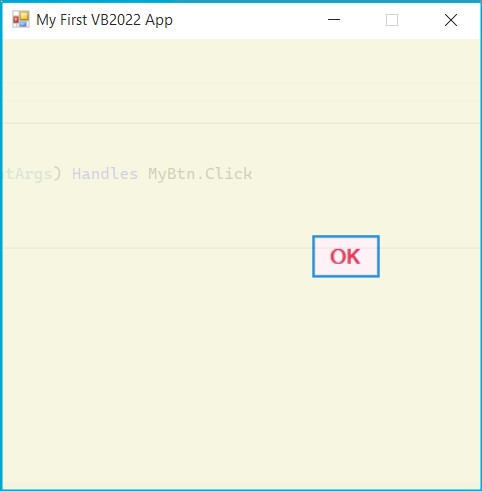
Lesson Summary
In this lesson, you've learned how to create professional user interfaces in VB2022:
UI Planning
Always sketch your UI design before implementation
Properties Window
The central place for customizing form appearance at design-time
Runtime Customization
Use the Me keyword to modify properties programmatically
Advanced Features
Positioning, sizing, and opacity control for professional interfaces
You've learned how to customize the VB2022 form both at design-time and runtime. In the next lesson, we'll explore how to enhance the UI with various controls and their properties.
Next Lesson
Ready to learn how to enhance the UI? Continue to Lesson 3: Enhancing the UI.
Related Resources

Visual Basic 2022 Made Easy
The ultimate beginner-friendly guide for mastering Windows-based application development using Visual Basic in Visual Studio 2022. Whether you're a student, teacher, hobbyist, or self-learner, this book offers a clear, step-by-step approach to help you get started with ease.
What You'll Learn:
- Master the Core Concepts of Visual Basic 2022: Gain a solid understanding of essential programming concepts such as variables, data types, control structures, procedures, and error handling—all explained in a beginner-friendly manner.
- Build Real Windows Forms Applications Step by Step: Learn how to design and develop functional Windows desktop applications using VB.NET and Windows Forms, complete with user interface controls, menus, and event handling.
- Enhance Productivity with Visual Studio 2022 Tools: Discover how to leverage the power of IntelliCode and GitHub Copilot for smart code suggestions, refactoring assistance, and faster debugging—all within the latest Visual Studio environment.
- Develop Problem-Solving and Logical Thinking Skills: Strengthen your ability to write clean, logical, and structured code through practical examples and hands-on exercises that mirror real-world scenarios.
- Package, Deploy, and Share Your Applications with Ease: Learn how to compile, package, and distribute your applications professionally—whether for personal use, academic submission, or commercial deployment.

Visual Basic Programming With Code Examples
A Practical Guide for Beginners and Intermediate Developers to Master Visual Basic programming—From VB6 to VB.NET. Unlock the power of Visual Basic with this comprehensive, hands-on guide that bridges the gap between classic VB6 and modern VB.NET programming.
What You'll Learn:
- Core Concepts Made Easy: Explore data types, control structures, file handling, procedures, user interface design, and more.
- Hands-On Application Building: Design real-world applications, including financial calculators, educational tools, games, multimedia apps, and database systems.
- 48 Practical Code Examples: Study and customize fully explained programs that illustrate key programming techniques.
- Handle errors and create UserForms
- Dual-Code Format: Learn to translate and adapt code between VB6 and VB.NET seamlessly.